
views
- Use clean water to wash your hands, face and feet. Then, focus on your intention to praise Allah.
- Stand facing the Qiblah and say, “Allahu Akbar” to begin the prayer.
- Recite the first chapter of the Qur’an to complete the first Rak’ah, and repeat the first Rak’ah plus an additional prayer to complete the second part.
- Repeat the first 2 Rak’ahs to complete the Isha prayer.
Preparation

Wash yourself with clean water before you begin. Before any prayer, you first perform “wudu,” or a ritual cleansing that prepares you for Salah. First, wash your hands and arms, then wash your face, gargling and inhaling a bit of water through your nose. Finally, wash your feet. Offer the Isha prayer after twilight each day, but before midnight. Use a site like IslamicFinder to find your local prayer times.
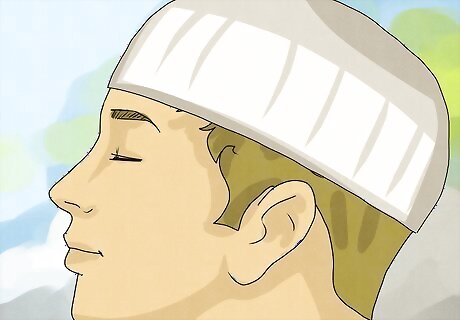
Set your intention while focusing your mind on prayer. Your intention (“niyyat”) is the purpose with which you do an act. Right now, your purpose is performing the Isha prayer while ending and reflecting on your day. Steady your breathing, center yourself, and focus on the prayer at hand. Contemplate Allah and the prayer before you. Niyyat is usually done silently, but it’s common to repeat the word “Bismillah” (“in the name of Allah”) to yourself in your head to help you settle into the moment. As you set your intention, think about how you went about your day, and resolve to go to bed after prayer with a clear mind oriented toward Allah.
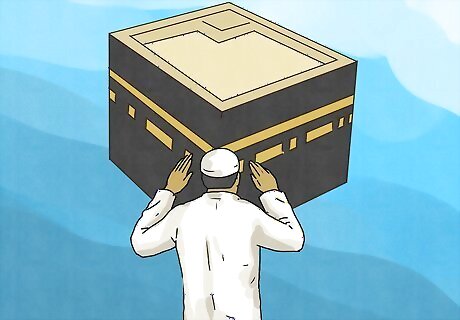
Stand and face Makkah, then say “Allahu Akbar.” Lift your hands to either side of your head and say the Takbir—”Allahu Akbar,” meaning “God is the greatest.” Then bring your right hand to your chest and say, “A’oothu billaahi minash-shaytanir-rajeem,” meaning, “I seek refuge with Allah from Satan the accursed.” Find Makkah (or “Mecca”) on a map or visit a Muslim prayer website to determine which direction to face. After saying the Takbir, avoid anything that would disrupt your state of prayer, like talking, laughing, drinking, eating, or visiting the restroom.
The First Rak’ah
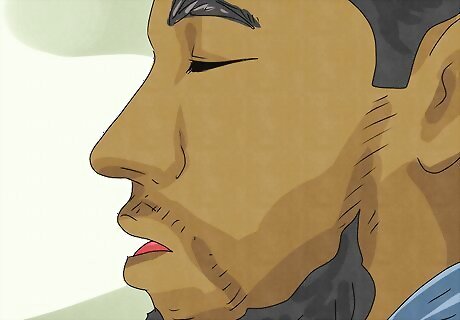
Say the first chapter of the Qur’an, followed by any other passage. While standing and with your right hand still over your chest, read or recite the entire first chapter (the “Surah al-Fatihah”), followed by any verse (or “surah”) you like. The Surah al-Fatihah is as follows: Bismillaahi’r-Rahmaani’r-Raheem / Al-hamdu lillaahi rabbil-`aalameen / Arrahmaanir raheem / Maaliki yawmid-deen / Iyyaaka na`budu wa iyyaaka nasta`een / Ihdinas-siraat al-mustaqeem / siraat al-ladheena an`amta `alayhim / ghayril maghdoobi `alayhim / wa la’d-daalleen / Ameen In the Name of God, the Merciful, the Compassionate / Praise belongs to God, Lord of the Worlds / the Merciful, the Compassionate / Master of the Day of Judgement / We worship only You and from You alone do we seek help / Lead us on the straight path / he path of those whom You have blessed / not of those on whom is [Your] Wrath / nor of those who have gone astray / Oh Allah answer our prayer!
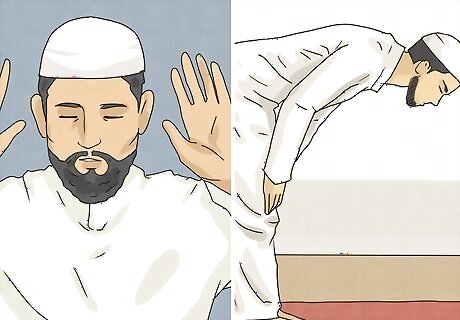
Say “Allahu Akbar,” then bow at the waist. Bring your hands to your earlobes and say Takbir. Then, bow (a position known as “ruku”) and recite the following 3 times: “Subhaana rabbiyal ‘atheem.” Then, while straightening your posture, say, “Sami’-Allaahu liman hamidah.” After, lower your hands to your side, bow your head, and say, “Rabbanaa wa lakal hamd.” These verses translate to, “Glory be to my Lord the Supreme,” “Allah listens to the one who praises Him,” and “Our Lord, and to You belongs the praise,” respectively.
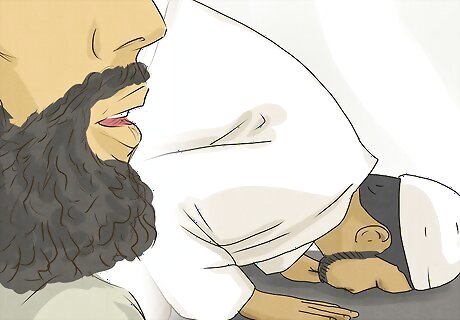
Recite 3 Takbirs while on your hands and knees. Lower yourself to the floor with your nose and forehead touching the prayer mat (a position known as “sujud”) and say “Allahu Akbar” 3 times. Then say, “Subhaana rabbiyal ‘alaa” (“Glory be to my Lord Most High”). Keep your palms flat on the floor, knees together, and feet upright with your toes touching the floor.

Rest on your heels and say “Allahu Akbar,” then, “Rabbighfirlee.” Sit upright and place your weight on your left thigh, resting your left foot parallel to the floor and keeping your right foot perpendicular and upright, with your toes bent forward toward the Qiblah. Place your palms on your knees and say, “Rabbighfirlee” (“Oh Allah, forgive me”).
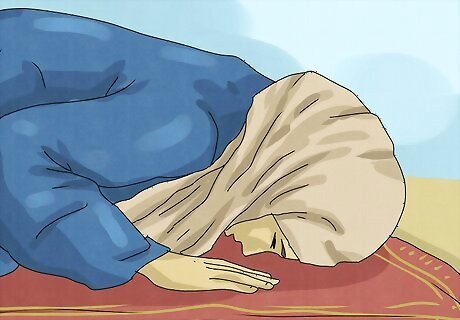
Return to sujud and say “Allahu Akbar.” Lean forward and place your forehead on the floor again, and say a Takbir. Then say, “Subhaana Rabbiy-al-Aalaa” (“Glory be to my Lord, the Highest”) 3 times. You’ve completed the first Rak’ah.
The Second Rak’ah

Stand upright and repeat the first Rak’ah. The second Rak’ah begins by repeating the entirety of the first. Stand from sujud, raise your hands to your earlobes and say, “Allahu Akbar.” Start the first Rak’ah over again , beginning with the Surat al-Fatiha and repeating it all the way through the final sujud.
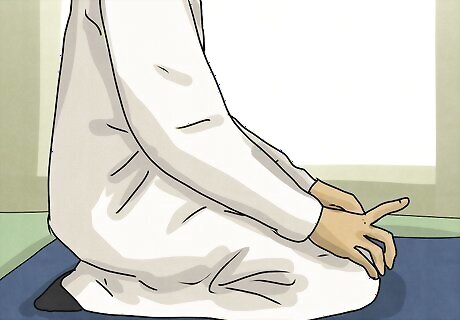
Kneel with your palms on your knees and your right index finger raised. After the final sujud of the repeated Rak’ah, sit upright and place your weight on your left thigh. Align your feet as before, and place your palms on your knees, lifting your right pointer finger to point toward Makkah.
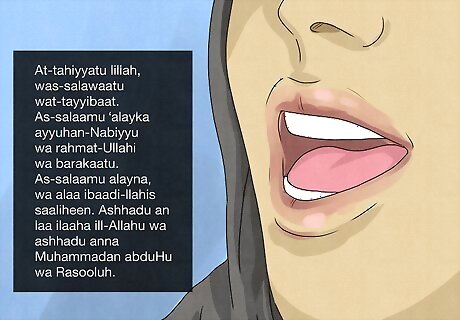
Recite the Tashahud. While sitting, recite, “At-tahiyyatu lillah, was-salawaatu wat-tayyibaat. As-salaamu ‘alayka ayyuhan-Nabiyyu wa rahmat-Ullahi wa barakaatu. As-salaamu alayna, wa alaa ibaadi-llahis saaliheen. Ashhadu an laa ilaaha ill-Allahu wa ashhadu anna Muhammadan abduHu wa Rasooluh.” This translates to, “All compliments are for Allah, and prayers and goodness. Peace be upon you, O Prophet, and the mercy of Allah and His blessings. Peace be upon us and on the righteous servants of Allah. I bear witness that there is no god but Allah and I bear witness that Muhammad is His servant and messenger.”
The Third and Fourth Rak’ahs

Perform the first Rak’ah once more. The third Rak’ah is another repetition of the first. However, instead of the Surat al-Fatiha, you might say the al-Tasbihat al-Arba’ah 3 times, as follows: “Subhaanallaahi wa’l hamdu lillaahi wa laa ilaaha illallaahu wallaahu akbar” (“Glory be to God, and praise be to God; there is no god but Allah, and Allah is Greater”).
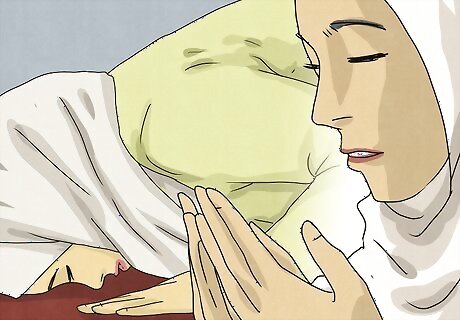
Perform the second Rak’ah once more. Similarly, the fourth Rak’ah is a repetition of the second, including the recitation of the Tashahud. You’ve now completed all 4 parts, and are ready to conclude the prayer.
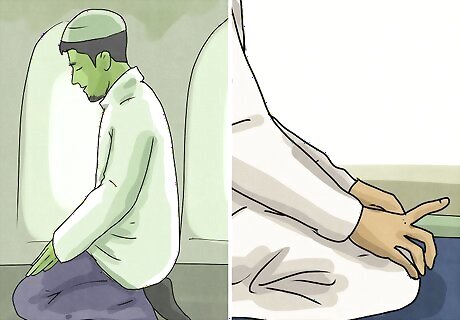
Sit in the ruku position. Sit on your heels with your right index finger lifted and say, “Allahumma salli alaa Muhammadiw wa alaa aali Muhammadin, kamaa sallayta alaa Ibraheema wa alaa aali Ibraheema, innaKa Hameedum Majeed. Allahumma baarik ‘alaa Muhammadiw wa alaa aali Muhammadin, kamaa baarakta alaa Ibraheema wa alaa aali Ibraheema, innaKa Hameedum Majeed.” This means, “O Allah, send Your mercy upon Muhammad and the family of Muhammad, just as You sent mercy upon Ibrahim and the family of Ibrahim. Truly You are Praiseworthy and Glorious. O Allah, send blessings upon Muhammad and the family of Muhammad, just as You sent blessings upon Ibrahim and the family of Ibrahim. Truly You are Praiseworthy and Glorious.”

Conclude with the Taslim. Remain sitting, turn your head to the right, and recite, “Assalaamu ‘alaykum wa rahmatullah,” (“May Allah’s peace and mercy be upon you”) then turn to the left and repeat the verse. This completes the last of the daily prayers.
















Comments
0 comment